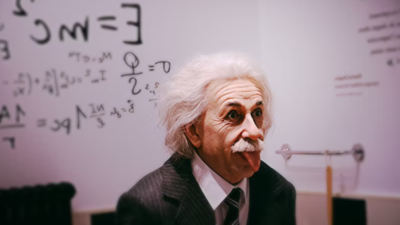
Albert Einstein, the man who revolutionised our understanding of space and time, regularly skipped university lectures. Marie Curie, the first woman to win a Nobel Prize, often collapsed from hunger whilst studying late into the night in a freezing Parisian garret.
Isaac Newton made his most groundbreaking discoveries not in the hallowed halls of Cambridge, but locked away in isolation during a deadly plague outbreak.These aren't tales of academic rebellion or hardship, they're glimpses into the unconventional study methods that shaped history's greatest minds. While most of us were taught to sit quietly in rows, take meticulous notes, and memorise facts for exams, the world's most brilliant scientists were breaking every rule in the educational handbook.What if everything we've been told about effective learning is wrong? What if the secret to genius isn't natural talent, photographic memory, or even prestigious education, but rather a fundamentally different approach to how we absorb and process knowledge? The study habits of history's most brilliant minds reveal fascinating patterns that challenge everything we think we know about effective learning. Here are unique study habits of some of the world's greatest minds.
Albert Einstein
Albert Einstein's academic journey defies conventional wisdom. At thirteen, he taught himself an entire year's worth of mathematics, not because he was forced to, but because his curiosity demanded it. Einstein found traditional classroom environments stifling, particularly those focused on rote memorisation. Even at university, he skipped lectures regularly, preferring to rely on classmates' notes whilst dedicating extensive time to studying theoretical physics independently.This wasn't laziness, it was strategic brilliance. Einstein understood that true learning happens when we take ownership of our education, following our curiosity rather than rigid curricula.
Issac Newton
Isaac Newton's most productive period came during 1665-1666, when a plague outbreak forced him to leave Cambridge. In isolation, he made groundbreaking discoveries that would revolutionise science. Newton combined deep theoretical reasoning with meticulous experimentation, building his own instruments and refining his methods over years.Similar to Einstein, he described himself as a "lone traveller" who valued solitude as essential to his intellectual process. This pattern suggests that genius often requires stepping away from the noise of conventional academic environments to think deeply and independently.
Richard Feyman
Richard Feynman revolutionised learning with his deceptively simple approach. He maintained a "Notebook of Things I Don't Know About," actively identifying knowledge gaps rather than avoiding them.
His method involved breaking down complex topics, reassembling them from first principles, and ensuring he could explain everything simply.This technique; now known as the Feynman Method, forces learners to confront their limitations honestly. If you can't explain something in simple terms, you don't truly understand it.
Marie Curie
Marie Curie's approach to study was defined by extraordinary perseverance against overwhelming odds.
Raised in Russian-occupied Poland, she pursued education through underground schools where forbidden subjects were secretly taught. At the Sorbonne, she endured extreme poverty, studying late into the night and often collapsing from hunger.Curie's method was rigorous and patient; she spent years extracting tiny amounts of radium under dangerous conditions, driven by pure scientific curiosity rather than recognition.
Her meticulous experimentation reflected her belief that science was a mission, not a performance.
APJ Abdul Kalam
Dr APJ Abdul Kalam's educational journey demonstrates the power of practical learning. From his early days in Rameswaram to his specialisation in aeronautical engineering, he consistently pursued education with determination despite financial challenges. His approach was notably hands-on, he didn't just absorb theoretical knowledge but applied it directly to real-world aerospace and defence challenges.Throughout his career, Kalam embraced continuous learning and innovation, understanding that true mastery comes from bridging theory and practice.
Rosalind Franklin
Rosalind Franklin studied with remarkable precision and independence, choosing science as her path at just sixteen. Her mastery of X-ray crystallography was exceptional, and she used this technique with extraordinary skill to investigate atomic structures. Often working in isolation due to institutional sexism, she upheld the highest standards of scientific inquiry, meticulously controlling experimental conditions and performing complex mathematical analyses.
Franklin's unwavering commitment to clarity and scientific truth, even in the face of discrimination, demonstrates that excellence transcends social barriers.
Where do all their strategies meet?
Several patterns emerge from examining these extraordinary minds:Independence over conformity: Each genius preferred self-directed learning over traditional educational structures. They followed their curiosity rather than prescribed curricula.Depth over breadth: Rather than superficial coverage of many topics, they pursued deep understanding of fundamental principles.Isolation as a tool: Solitude wasn't loneliness, it was a deliberate strategy for deep thinking and focus.Practical application: They didn't just learn theory; they applied knowledge to solve real problems.
Embracing difficulty: Instead of avoiding challenging topics, they actively sought out what they didn't understand.

 9 hours ago
54
9 hours ago
54




























 English (US)
English (US)